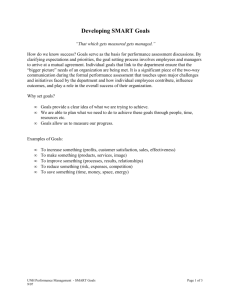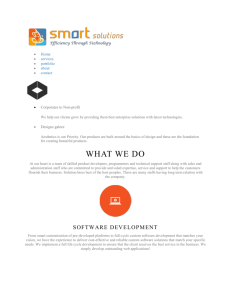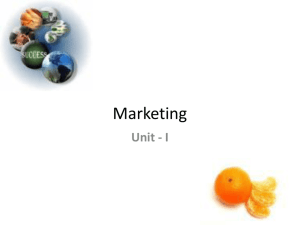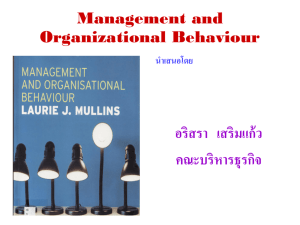9-9-10 - Dunlap Community Unit School District #323
advertisement
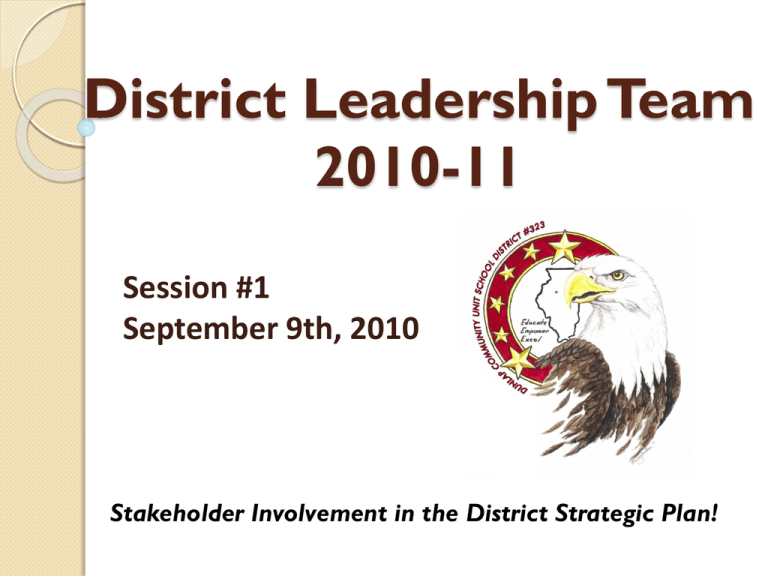
District Leadership Team 2010-11 Session #1 September 9th, 2010 Stakeholder Involvement in the District Strategic Plan! Welcome! Introductions ◦ Name, Stakeholder Group, School Find someone you don’t know and introduce yourself Share a reason why you are interested in serving on this committee Housekeeping… Use of email & web site 3 Ring Binder Possible Sub-Committees Future Meetings ◦ November 16th, 2010 6-8pm; DVMS ◦ January 20th, 2010 6-8pm; Ridgeview ◦ April 12th, 2010 6-8pm; DHS Click on “Strategic Planning” on the left side main menu- District web site District Leadership Team Session #1 September 8th, 2010 - Dunlap Middle School 6:00pm – 8:00pm Time Item 5:45 – 6:00 pm Social/Evening Refreshments 6:00 – 6:15 pm Welcome, Introductions, Housekeeping, Key Tasks 10-11 6:15 – 7:00 pm District Strategic Plan District SMART Goals/Action Plans District Balanced Scorecard 7:00 – 7:10 pm Break 7:10 – 7:50 pm Providing Stakeholder Input Stakeholder Satisfaction Surveys Release Time for Professional Development 7:50 – 8:00 pm Meeting Evaluation Next Steps Our Purpose The purpose of the District Leadership Team is to provide oversight and the “voice of the customer” during the implementation of the 3-5 year District Strategic Plan. 2010-11 Key tasks/Timelines Monitor the District Strategic Plan ◦ Review SMART goals & Action Plans ◦ Review Balanced Score Card Provide Input on District Initiatives ◦ Serve as the “Voice of the Customer” ◦ Stakeholder Satisfaction Surveys (2010-11) ◦ Early Release for Teacher Planning (2011-12) Characteristics of High Performing Schools 1. Common mission, vision, values and goals. 2. Ensuring achievement for all students with systems for prevention and intervention. 3. Collaboration focused on teaching and learning. 4. Using data to guide decision-making and continuous improvement. 5. Gaining active engagement from family & community 6. Building sustainable leadership capacity. SET AND COMMUNICATE DIRECTION! Core Values Vision & Mission Goals & Strategies District Strategic Plan “The focus is on achieving a shared vision, and all understand their role in achieving the vision” All facilities now have a large framed poster of the District Plan on a Page! Random Acts of Improvement Aim of the Organization Goals and Measures Aim of the Organization Goals and Measures Aligned Acts of Improvement The School’s Mission The School’s SMART Goals Department Mission Department SMART Goals Classroom Mission Classroom SMART Goals District Strategic Plan District Leadership Team School/Dept. Leadership Teams PLC’s (Grade/Content) Classroom Learning Community Ground rules created by students Classroom mission statements Quality tools and PDSA used regularly The Continuous Improvement Classroom Classroom meetings facilitated by students Student-led conferences Classroom and student measurable goals Classroom data centers Student data folders Building a Mission Statement 4th grade used an Affinity Diagram to build… …their mission statement! Data Centers Classroom Goals… SMART Goal Examples Aligned Acts of Improvement District Strategic Plan “Critical Few” GOALS Leadership Teams: Setting & Communicating Direction Schools Classrooms PLC Teams Students “The focus and vision are developed from common beliefs and values, creating a consistent direction for all involved” District SMART Goals/Action Plans SMART Goals/Action Plans Everyone has a copy of all 8 goals/plans Number off by 8 Review the SMART goal and action plan Provide a “high level summary” to the group in your own words… ◦ Read the SMART goal ◦ Summarize key steps in the action plan ◦ Provide any other comments, suggestions related to the SMART goal/action plan Dunlap Balanced Scorecard Each of the 5 goals in the strategic plan have identified “indicators” or “measures” Historic data as well as projections (coming soon!) DLT will review the scorecard and data when it is available Moving toward a data warehouse that will provide real time “dashboard” of results Voice of the Customer Scorecard measures satisfaction levels ◦ ◦ ◦ ◦ ◦ ◦ ◦ ◦ ◦ 2.A Increase elementary students overall satisfaction with school 2.B Increase middle school students overall satisfaction with school 2.C Increase high school students overall satisfaction with school 2.E Increase the % of students who feel safe and accepted at school 3.B Increase certified staff satisfaction 3.C Increase support staff satisfaction 4.A Increase parent overall satisfaction 4.B Increase community member overall satisfaction 4.C Increase the % of parents who agree that "school is welcoming and friendly" ◦ 4.D Increase effective communication with parents ◦ 4.E Parents feel positively about school safety and climate Underlying Theory If you do not measure it, you will not change it Not all problems are equal. Some have more IMPACT than others Satisfaction/Motivation are key attitudes which are leading indicators of performance Attitudes are formed from experience 31 Identify experiences that relate most to satisfaction * Harris Interactive School Poll Topic Areas Students Parents School Atmosphere School Atmosphere Equipment/Facilities Equipment/Facilities Equipment/Facilities School Bus School Bus Computer Technology Computer Technology School Leadership/ Administration School Leadership/ Administration Communications/ Involvement Communications/ Involvement School Leadership Parental Support Child’s Teachers Counselor Career Curriculum/Training Other Staff Students Budget Other Issues Other Staff Other Issues Computer Technology Main Teacher/ Teachers (five subjects) 32 Teachers/Staff Other Issues Elementary Students: School Atmosphere Yes No Are students well-behaved while in school? Do you feel safe walking to and from school? Do you feel safe while in school? Are the rules at your school fair? Are most other students nice to you? Please give an overall rating for your SCHOOL ATMOSPHERE by filling in one oval on the A to F scale provided? 33 A A B+ B B C+ C D+ D D F 10 9 8 7 6 5 4 3 2 1 0 Harris Interactive Inc. OVERALL SATISFACTION MODEL: ELEMENTARY STUDENTS Elementary Students Satisfaction Rating Distribution Sample Improvement Possible A B C D Current Score Max. Possible Score F 9.9 10 Do you like the food served in the lunch room? Do you get extra help when you need it? Are school bathrooms clean? Are students well-behaved on your bus? Is your school too crowded? Does the school library meet your needs? Are the rules at your school fair? Main teacher: Help you want to learn? Is the temperature in your classrooms usually comfortable? Main teacher: Ask you to answer questions in class? Is your classroom teacher prepared to train you on the computer? Are you well-behaved at school? Do you participate in class? 34 41% 24% 58% 50% 39% 24% 28% 11% 21% 18% 16% 10% 6% 0.8 1.1 0.4 0.4 0.4 0.5 0.4 1.0 0.5 0.5 0.7 0.5 0.8 IMPACT INDEX 18% 14% 11% 11% 7% 7% 6% 6% 5% 5% 5% 3% 2% 8 Satisfaction Level ISSUES INFLUENCING OVERALL SATISFACTION % with Problem Penalty 6 4 2 0 7.8 Improvement Possible Sample Current Score Max. Possible Score 9.9 10 Satisfaction Level 8 6 4 2 0 35 7.8 This graph shows the current overall satisfaction mean rating with the maximum possible score. The gap between them is the opportunity for improvement. Satisfaction Surveys Next Steps Timeline for survey administration: April, 2011 (results back in late May/early June) ◦ Run a survey campaign to generate interest and a high return rate Dunlap may customize up to 10 questions for students, parents and staff ◦ DLT will help formulate the extra questions) Next meeting: ◦ More details of the survey, review of sample reports, drafting of additional questions Voice of the Customer Release time for teachers to engage weekly in a Professional Learning Community (PLC)! There is currently no “time” built into the schedule for teachers to meet weekly PLCs are a key strategy in the deployment of the strategic plan Paradigm Shift (School Improvement- PLC’s) Traditional Approach A small group of teachers were included on the school improvement team Most people did not know the goals and action plans Actions were random Continuous Improvement Everyone is included on an improvement team Everyone is working toward common and shared goals No one escapes continuous improvement Example of Creating “Time” Add 15 minutes to the school day: ◦ ◦ ◦ ◦ MondayTuesdayThursdayFriday- add 15 minutes add 15 minutes add 15 minutes add 15 minutes +60 minutes Release 60 minutes early on Wednesdays for PLC time (replace with the additional 60 min.) Instructional time and contract day neutral! Need Stakeholder Input! Subcommittee to recommend a proposal to the board: Strategy for creating “time” for PLCs to meet Input from stakeholders (parents, teachers and other “impacted” stakeholders Complete a Force Field Analysis to determine driving and restraining forces to implement this initiative Recommend solutions to items identified as a “restraining force” to optimize implementation ◦ Create a communication plan to inform stakeholders and the community District Leadership Team Meeting – Participant Feedback Please Circle One Parent Student Teacher Support Staff Administrator/Board Member Strongly Disagree Other Strongly Agree 1. Overall, the meeting was well organized. 1 2 3 4 5 2. The meeting included an effective level of participation and involvement. 1 2 3 4 5 3. Facilities and accommodations were conductive. 1 2 3 4 5 4. Plus/Delta comments: Plus (What did you like about today’s meeting?) Delta (What could we change/do differently?) 5. Please list any topics you would like to see addressed at future District Leadership Team meetings.

